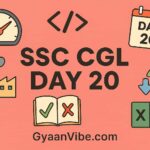GyaanVibe is a focused educational platform dedicated to helping SSC CGL aspirants crack Tier 1 & Tier 2 exam with a strategic, day-wise, and well-structured preparation approach.
SSC CGL Preparation – Day 9
Practice Questions: Constitution of India
1. Who is regarded as the Chief Architect of the Indian Constitution?
A. Jawaharlal Nehru
B. B. R. Ambedkar
C. Sardar Patel
D. Rajendra Prasad
Answer: B. B. R. Ambedkar
Explanation: Dr. B. R. Ambedkar was the Chairman of the Drafting Committee and played a pivotal role in framing the Constitution.
2. When did the Constitution of India come into force?
A. 15 August 1947
B. 26 November 1949
C. 26 January 1950
D. 30 January 1948
Answer: C. 26 January 1950
Explanation: The Constitution was adopted on 26 November 1949 but came into force on 26 January 1950, celebrated as Republic Day.
3. Which part of the Constitution contains the Fundamental Rights?
A. Part II
B. Part III
C. Part IV
D. Part V
Answer: B. Part III
Explanation: Fundamental Rights are mentioned from Article 12 to 35 in Part III.
4. Which schedule of the Constitution contains the names of States and Union Territories?
A. First Schedule
B. Second Schedule
C. Third Schedule
D. Fourth Schedule
Answer: A. First Schedule
Explanation: The First Schedule lists the names of States and Union Territories and their territorial jurisdiction.
5. Which amendment is known as the “Mini Constitution”?
A. 44th Amendment
B. 42nd Amendment
C. 73rd Amendment
D. 86th Amendment
Answer: B. 42nd Amendment
Explanation: The 42nd Amendment Act, 1976, made major changes and added terms like “Socialist”, “Secular”, and “Integrity” to the Preamble.
6. The Directive Principles of State Policy are taken from the Constitution of:
A. USA
B. UK
C. USSR
D. Ireland
Answer: D. Ireland
Explanation: The concept of Directive Principles of State Policy in the Indian Constitution is inspired by the Irish Constitution.
7. The Preamble of India does NOT include which of the following terms?
A. Sovereign
B. Socialist
C. Democratic
D. Capitalist
Answer: D. Capitalist
Explanation: The Preamble includes Sovereign, Socialist, Secular, Democratic, Republic, but not “Capitalist”.
8. How many Fundamental Duties are mentioned in the Indian Constitution?
A. 9
B. 10
C. 11
D. 12
Answer: C. 11
Explanation: Originally 10 Fundamental Duties were added by the 42nd Amendment, the 11th was added by the 86th Amendment in 2002.
9. The Constitution of India borrowed the concept of a Concurrent List from:
A. UK
B. USA
C. Australia
D. South Africa
Answer: C. Australia
Explanation: The concept of a Concurrent List, where both Centre and States can legislate, was borrowed from Australia.
10. Who was the first President of the Constituent Assembly?
A. Dr. B. R. Ambedkar
B. Jawaharlal Nehru
C. Rajendra Prasad
D. Sardar Vallabhbhai Patel
Answer: C. Rajendra Prasad
Explanation: Dr. Rajendra Prasad was elected as the permanent President of the Constituent Assembly.




